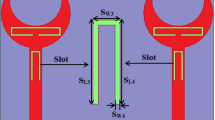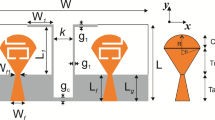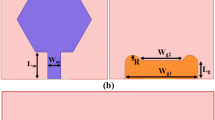Abstract
In this article compact multiple input multiple output (MIMO) antenna with triple notch at the ultra-wideband application having two identical monopole antennas is proposed. The two inverted ‘U’ shaped slots are etched on the antenna geometry. The proposed antenna gets notch obtain notch characteristics at three frequencies i.e. 3.51–4.3 (WiMAX), 5.5–5.6 (WLAN) and 8.4–8.8 (X-band applications in UWB spectrum the proposed antenna is designed on FR4 substrate with a compact size of 20 × 34 × 1.6 mm3. The proposed antenna was designed and analysed HFSS 13. An excellent triple notch characteristic is obtained after insertion of Inverted ‘U-shaped compact slot on the radiators. At the centre of the triple notch bands a significant drop in the gain, efficiency of the antenna is seen this indicates a good suppression in the interference of two elements. The simulated and measured results show that the proposed is used for UWB MIMO diversity systems. Thus the proposed antenna two elements are used reduce isolation between channels for ultra wideband MIMO diversity systems.
Similar content being viewed by others
Avoid common mistakes on your manuscript.
1 Introduction
The recent years witnessed an extensive growth in ultra wide band technologies due to its essential needs such as high datarate, lowcost with lowpower. The Federal Communication Commission (FCC) allowed 3.1–10.6 GHz band as ultra wideband which is unlicensed [1]. The gradual raise in the different antenna configurations given rise to MIMO technology in the antenna scenario. The main challenge for the MIMO antennas to minimize the elements placed in the antenna geometry and the other is to enhance the isolation between those elements. The directional gain antennas which are integrated in MIMO antennas to reduce the mutual coupling which will have slight effect in the wideband impedance matching for ultra wide band applications.
For this problems to overcome Ren et al. [2] proposed a compact MIMO antenna which is used for UWB applications with low mutual coupling of less than 15 dB. Liu et al. [3] proposed a portable MIMO antenna for ultra wideband applications considering two planar monopole antennas. Zhu et al. [4] proposed an antenna at ultra wideband region for withy MIMO diversity and band rejection capabilities. To achieve polarization diversity at ultra-wideband applications by Chack et al. [5] proposed an antenna which is slotted uniplanar. Ma et al. [6] proposed an antenna with dual polarization with MIMO configuration. A ACS fed diversity MIMO antenna which is used for ultra wideband applications is proposed by the Liu [7]. Sonika et al. [8] proposed a ultra wideband MIMO antenna which works with a single rejection band at 4.98–5.96 GHz with a good isolation level which is less than 20 dB. Sipal [9] proposed a compact 2 × 2 and 4 × 4 MIMO antenna to cover the wireless portable devices for UWB antennas. Liliu et al. [10] proposed a compact input multiple input multiple output antenna for ultra wide band applications with the use of quasi self-complementary structures. In this article the author claimed that the antenna mutual coupling is less than − 15 dB which is a good candidate for portable UWB applications. Liliu et al. [11] proposed an ultra-wide band MIMO antenna with single notch in UWB spectrum. Zhang et al. [12] proposed an tree like structure to increase isolation in the MIMO antennas. The measured isolation in this article is − 16 dB almost. Chandel et al. [13] proposed a tapered UWB MIMO antenna with two bands notching [14]. Gao et al. have designed an antenna which operates at 2.5 GHz having a planar flipped F-shaped modified planar which is on the mobile geometry. With the effect of capacitive loaded with miniature the antenna shows its desired properties. The antenna dimension is reduced substantially with a miniature ground plane and capacitive loading [15,16,17]. Tao et al. have proposed an antenna a half slot structured compact MIMO antenna which works in ultra-wideband (UWB) applications.
In this article a compact multiple input multiple output antenna is proposed for ultra wideband applications. The proposed modal consists of three notch band in the ultra-wideband region. The design of the antenna is done using HFSS software and the fabricated on the FR4 substrate. The correlation between the two ports of the MIMO antenna is also simulated and measured. The isolation and parametric analysis and radiation patterns etc. are explained in the below sections.
2 Antenna Design
The basic MIMO antenna is designed using the flag shaped structure with half ground structure and both the flag structures are arranged in the opposite direction to attain less mutual coupling between the both the radiating elements. FR4 material is selected as the substrate material which is having 4.4 dielectric constant and loss tangent of 0.02 and designed using HFSS software. Further in the next iteration to attain the less mutual coupling the ground structure is further modified by placing the slots in the ground plane. The added slots in the ground is modified with the circular ring loaded with the line stubs which will be separate the effects of mutual coupling in the elements. In the third iteration modification is done on the top of the substrate by placing the circular ring with added stub on the ring in between the radiating elements. The below equations is calculated for resonant frequencies and length of the patch of the single antenna element
Width of the strip is calculated using
2.1 Modified Inverted U-Shaped Slot for Band Notch Characteristics
The spectrum which is covered in UWB region can re-signed by the WiMAX (3.3–3.7 GHz) and WLAN (5.15–5.85 GHz) because of its high data rates and spectrum allocation. Because of this bands. The ultra-wide band spectrum causes and it shows electromagnetic interference in that spectrum. To solve this issue, modified Inverted U-shaped slot has been designed and implemented over the planar monopoles as shown in Fig. 1b. This modified U-shape is said to occupy lesser space than a Euclidian notch. In general the slot on the antenna geometry acts as a quarter (guided) wavelength which is said to be parallel open circuit transmission line that shorts the antenna at a relevant notch frequency. The total length of this Inverted U-shape slot is about half wavelength of the centre frequency of the notch band which can be calculated by
Here, the effective dielectric constant (εeff) of the taken substrate is FR4 material, considering the structure of the ground plane. c is the speed of light, Fnotch the centre frequency of the notch band, and S the total length of the E-shaped slot. SL, SW, RW are the essential design parameters as shown in Fig. 1b. The Fig. 1 presents the detailed view of the proposed antenna.
Parameter | SW | SL | Sw1 | SL1 | R1 | R2 | Stl | StW | Pw | TW | Lf | PL |
Value (mm) | 2.5 | 2.5 | 1.5 | 1.5 | 4 | 3.8 | 10 | 1 | 5 | 3.8 | 7.25 | 7.5 |
Parameter | GSW1 | GSL1 | L4 | R3 | L2 | L1 | W1 | L7 | L6 | L5 | L3 | Rw |
Value (mm) | 12 | 6 | 3.2 | 3.6 | 2 | 23 | 6.5 | 1.8 | 6 | 6 | 2 | 1 |
3 Results and Discussion
In the iteration 1 of the antenna consists of flag shaped structure arranged in the opposite direction. The antenna operates in the dual band range which is operating the range of 3.15–3.76 GHz with the bandwidth of 0.61 and second band ranging from 5.06 to 9.5 GHz with the bandwidth of 4.44 GHz with minimum of S11 of − 18 dB. In the iteration 2 of the antenna shows the similar reflection coefficient but with higher bandwidth ranging from the 3.125 to 3.76 GHz and second band of 5.06–11.7 GHz with bandwidth of 6.64 GHz. The antenna is further modified with circular ring and stub loaded to ring which makes antenna to operate in the UWB frequency range of the antenna with wide of 2.55–11.18 GHz with wide bandwidth of 8.63 GHz with minimum S11 of − 27 dB and − 30 dB at the 3.5 and 9 GHz and covers the wide band of UWB frequencies. The antenna is further modified to obtain the notch band Characteristics by placing the U-shaped slot on the patch and at the feed line and a line slot in the ground plane with length L1 of the antenna has attained the notch band characteristics. The antenna operating in the frequencies of 2.52–3.5 GHz, 4.42–5.55 GHz and 6.73–8.4 GHz with notch bands of 3.51–4.3 GHz, 5.5–5.6 GHz and 8.4–8.88 GHz. The notch attained in the designed structure is used to reject some the frequencies applications like WiMAX (3.5–3.7 GHz), WLAN (5.75 GHz) and some of the X-band applications (Fig. 2).
The parametric analysis is carried out to select the best value of the parameter for the added stub width (StW), ground slotted rectangular length (L1), patch slot (PL) and circle radius (R1) is presented in this article. In the first and for most the stub loaded to circular ring in between the two radiating elements of the antenna is presented in the Fig. 3. As the stub is placed in between the radiating elements the antenna performance wise variation of the width doesn’t produce much variation in the reflection coefficient of the antenna. So, when the stub width is varied from 0.5 to 2 mm with step size of 0.5 mm it doesn’t show any variation. The observed values of the antenna operate in the range of 2.64–3.5 GHz, 4.4–5.4 GHz and 6.5–8.6 GHz with bandwidths of 0.86 GHz, 1 GHz and 2.1 GHz. The observation is that with the variation in the stub width doesn’t show any effect in the reflection coefficient of the antenna (Fig. 4).
The L1 parameter indicates the length of the ground slot with large length, to get the notch band performance the one of parameter tuned attain the notch band characteristics from the wide band characteristics. The observation from the graph is that when the length of the ground slot is increased to higher values like 54 and 25 mm the notch band performance of the antenna is improved, and the notch band is observed at the 5.8–7 GHz when the ground slot is 25 mm.
The slot on the radiating patch is varied from the 6.5 to 9.5 mm with the step size of 1 mm. The reflection coefficient characteristics of the antenna are in the Fig. 5 the antenna almost shows the triple band notch characteristics ranging from 8.5 mm. For the remaining cases the antenna shows the dual notch band and for 9.5 GHz it shows the wide band characteristics. The parameter effects on the reflection losses of the antenna is quite small but tuning toward to the notch band characteristics is observed.
By varying the circle ring radius, the antenna performance of the antenna is studied. The reflection coefficient of the antenna doesn’t show much variations in the frequency of operation, but the resonating frequencies of the antenna is different for the R1 = 4.4 mm for this parameter value the antenna shows the single notch band at the 5.8 GHz. when the circular radius value is 4 mm the antenna shows the wide band with single notch characteristics. For the remaining 3 values the variation of the radius of the circle can create the more notch band characteristics (Fig. 6).
4 Diversity Pattern
The primary requirements of MIMO antenna is that diversity antenna elements to be effectively deployed in pattern diversity. It means the pattern is uncorrelated due to the mutual coupling of the adjacent elements. To rectify correlation between each antenna can be studied with the help of obtained s parameters in below equation.
At normal operating conditions, the ECC should be less than 0.5 which means it indicated the limit of the signal detection. In the proposed modal the u slot which is an isolation structure placed on the patch of the antenna geometry is less than the mentioned value. So it indicated the ECC is less than 0.5 for the operating band of values (Fig. 7).
The proposed antenna fabricated modal and its measurement is measured using anristu VNA and its pictures are shown in Fig. 8 and the measured s-parameters values have been plotted in the Fig. 8.
The proposed antenna and its superiority is explained with a table in this the antenna is compared with diferent MIMO literature is presented in Table 1 and in Fig. 9 the E-Field distribution of the proposed antenna is explained as the fields tend to show the polarization diversity Fig. 10 explains the E and H plane radiation patterns of the proposed antenna at two frequencies’- plane exhibits dumbbell pattern and h-plane represents the quasi Omni directional pattern as shown in Fig. 10.
5 Conclusion
The novel MIMO antenna is presented to improve the isolation by using the stubs loaded in the ground structure. The novelty of the proposed antenna lies in the coupling structure to alter the isolation between the two elements. The antenna is very compact with the dimensions of 20 × 34 × 2 mm with notch band frequencies of 3.51–4.3 GHz, 5.5–5.6 GHz and 8.4–8.88 GHz which reject the applications like Wi Max (3.5–3.7 GHz), WLAN (5.75 GHz) and some of the X-band applications. The notch bands of the antenna are obtained by placing the ‘U’-shaped slots on the feed line and on the radiating element of the patch antenna. The antenna performance is evaluated by calculating the envelope correlation at operating range of frequencies. The omnidirectional radiation patterns and compact size made the antenna a good candidate for wireless applications. Thus these factors prove the proposed antenna is a good candidate for ultrawideband communication bands.
References
FCC. (2002). Washington. DC, Federal Communications Commission revision of Part 15 of the Commission’s rules regarding ultra-wideband transmission systems. First Report Order FCC 2: V48.
Ren, J., et al. (2014). Compact printed MIMO antenna for UWB applications. IEEE Antennas and Wireless Propagation Letters, 13, 1517–1520.
Zhu, J., et al. (2016). Compact dual-polarized UWB quasi-self-complementary MIMO/diversity antenna with band-rejection capability. IEEE Antennas and Wireless Propagation Letters, 15, 905–908.
Mao, C.-X., & Chu, Q.-X. (2014). Compact coradiator UWB-MIMO antenna with dual polarization. IEEE Transactions on Antennas and Propagation, 62(9), 4474–4480.
Chacko, B. P., Augustin, G., & Denidni, T. A. (2013). Uniplanar slot antenna for ultrawideband polarization-diversity applications. IEEE Antennas and Wireless Propagation Letters, 12, 88–91.
Liu, Y.-F., Peng, W., & Qin, H. (2014). Compact ACS-fed UWB antenna for diversity applications. Electronics Letters, 50(19), 1336–1338.
Biswal, S. P., & Das, S. (2018). A low-profile dual port UWB-MIMO/diversity antenna with band rejection ability. International Journal of RF and Microwave Computer-Aided Engineering, 28(1), e21159.
Sipal, D., Abegaonkar, M. P., & Koul, S. K. (2018). Compact planar 2× 2 and 4× 4 UWB MIMO antenna arrays for portable wireless devices. Microwave and Optical Technology Letters, 60(1), 86–92.
Liu, L., Cheung, S. W., & Yuk, T. I. (2014). Compact multiple-input–multiple-output antenna using quasi-self-complementary antenna structures for ultrawideband applications. IET Microwaves, Antennas & Propagation, 8(13), 1021–1029.
Liu, L., Cheung, S. W., & Yuk, T. I. (2015). Compact MIMO antenna for portable UWB applications with band-notched characteristic. IEEE Transactions on Antennas and Propagation, 63(5), 1917–1924.
Zhang, S., et al. (2009). Ultrawideband MIMO/diversity antennas with a tree-like structure to enhance wideband isolation. IEEE Antennas and Wireless Propagation Letters, 8, 1279–1282.
Chandel, R., Gautam, A. K., & Rambabu, K. (2018). Tapered fed compact UWB MIMO-diversity antenna with dual band-notched characteristics. IEEE Transactions on Antennas and Propagation, 66(4), 1677–1684.
Mathur, R., & Dwari, S. (2018) Compact cpw-fed ultrawideband mimo antenna using hexagonal ring monopole antenna elements. AEU-International Journal of Electronics and Communications. https://doi.org/10.1016/j.aeue.2018.05.032.
Khan, M. S., et al. (2017). A compact CSRR-enabled UWB diversity antenna. IEEE Antennas and Wireless Propagation Letters, 16, 808–812.
Tao, J., & Feng, Q. (2017). Compact ultra wide band MIMO antenna with half-slot structure. IEEE Antennas and Wireless Propagation Letters, 16, 792–795.
Gao, Y., et al. (2007). Design and performance investigation of a dual-element PIFA array at 2.5 GHz for MIMO terminal. IEEE Transactions on Antennas and Propagation, 55(12), 3433–3441.
Ramadhan, A. J. (2018). Wearable smart system for visually impaired people. Sensors, 18(3), 843.
Acknowledgements
We are very thankful for Department of ECE GITAM University Visakhapatnam for their support and encouragement to do research in Antennas. We also thank KL University, Guntur for their support and facility to fabricate and test the Antenna.
Author information
Authors and Affiliations
Corresponding author
Additional information
Publisher's Note
Springer Nature remains neutral with regard to jurisdictional claims in published maps and institutional affiliations.
Rights and permissions
About this article
Cite this article
Prasanth Kumar, J., Karunakar, G. Compact UWB-MIMO Triple Notched Antenna for Isolation Reduction. Wireless Pers Commun 115, 2113–2125 (2020). https://doi.org/10.1007/s11277-020-07673-9
Published:
Issue Date:
DOI: https://doi.org/10.1007/s11277-020-07673-9














